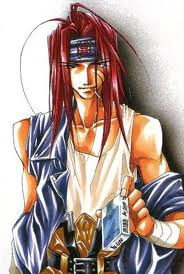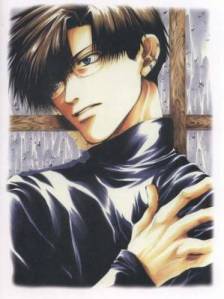The third member of the Sanzo party we are going to look at, Sha Gojyo, is quite possibly the most heartbreaking character to analyze. This is because he is a Cassanova who does not believe in love. At least that’s what he tells himself. He is the type of character that feels it is far safer to keep his distance from other people. While he is not as angry as Sanzo, he is not open like Hakkai either, a fact which makes it difficult to understand what exactly is going on under the surface.
As with his companions, the best way to understand Gojyo is to look at his past. He is a half-demon, a taboo child hated by everyone. His stepmother, whom he loves as a mother, tries to kill him because he is a reminder of the woman his father had an affair with. His half-brother has to go as far as killing her to save him. A past like that is going to leave a few scars.
What is love, anyway? Not that I want it.
This bitter statement reflects the hollow death inside Gojyo. On the outside, he is a confident, sarcastic, lacivious playboy. He is a man who does whatever he feels like, and consequences be damned. But all the cigarettes and beer and gambling and women in the world cannot fill the hole inside him that yearns for love and a strong bond with another human being. So he keeps trying to fill it, and he keeps failing.
Why? Because, he doesn’t realize that he already has what he’s looking for.
As with Sanzo’s obsession with “embracing nothing,” Gojyo’s bitterness and fear of lonliness are acts of contradiction. The very fact that he has three close friends (and one particularly close one, I might add) proves that he is not nearly as empty and alone as he thinks. He’s so stuck on the guilt and the sadness of his past that he cannot fully give himself to the people around him.
But that does not stop them from loving him. And towards the end of the series, he seems to finally figure that out.
My response to Gojyo is simple:
You already know what love is.
Just look at the people who haven’t abandoned you or given up on you.
Calm, quiet patience and simple sacrifice for the sake of the loved one.
That’s what love is.
–The Anime Philosopher
Next time, we will discuss Homura and Obsessive Love



